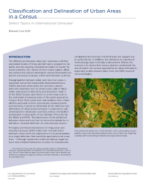
An official website of the United States government
Here’s how you know
Official websites use .gov
A .gov website belongs to an official government organization in the United States.
Secure .gov websites use HTTPS
A lock (
) or https:// means you’ve safely connected to the .gov website. Share sensitive information only on official, secure websites.
-
//
- Census.gov /
- Select Topics in International Censuses /
- Mapping /
- Classification and Delineation of Urban Areas in a Census
Classification and Delineation of Urban Areas in a Census
Classification and Delineation of Urban Areas in a Census
Introduction
The differences between urban and rural areas and their associated modes of living are both easily grasped by the public and are ongoing, fundamental topics of inquiry for social scientists. Our notion of what makes a place urban are context and culture dependent, varying from person to person and group to group, within and between countries.
Disaggregation between urban and nonurban areas is important across the Sustainable Development Goals (SDGs) because urban areas are commonly associated with amenities such as paved roads, safe drinking water, and access to electricity and education. Goal 11 of the SDGs focuses specifically on urban areas due to the continually increasing share of the world population living in them. Both urban and rural residents face vulnerabilities particular to their physical and socioeconomic environments. Interest in refinement of the definition and delineation of urban areas increased in response to suburbanization in developed countries and as urbanization accelerated in many parts of sub-Saharan Africa during the 1960s and 1970s. The importance of the distinction between urban and rural has not since diminished, but a definitive, universal definition of urban remains elusive.
Principles and Recommendations for Population and Housing Censuses (2015) notes that “the distinction between urban and rural populations is not yet amenable to a single definition that would be applicable to all countries…” Although researchers and international organizations have created frameworks to allow for standardized comparison and analysis, this brief does not suggest any as authoritative. In addition, any reference to a particular methodology does not imply endorsement. Rather, the purpose is to ensure that census planners understand the use of data in the various approaches to urban delineation, especially as data dissemination from the 2020 round of censuses begins.
- This technical note is available in English, Russian, and Arabic.
Share
Related Information
 Yes
Yes
 No
NoComments or suggestions?


Top


